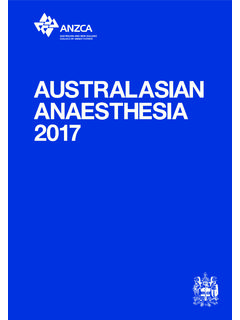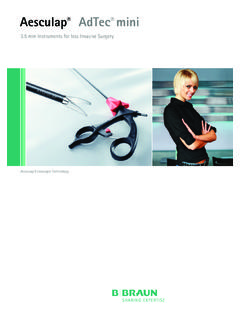Transcription of Australian and New Zealand College of Anaesthetists (ANZCA)
1 PS56. 2012. Australian and New Zealand College of Anaesthetists (ANZCA). Guidelines on Equipment to Manage a Difficult Airway During Anaesthesia 1. PURPOSE AND SCOPE. Airway complications are a leading cause of morbidity and mortality in anaesthesia. Effective management of a difficult airway is a core skill for Anaesthetists , and depends on the timely availability of suitable airway equipment. This document provides recommendations for the equipment needed to manage a difficult airway, the location in which it should be kept, and the quality assurance measures required to ensure that it is always available and in good working order 2. BASIC REQUIREMENTS FOR MANAGING THE AIRWAY WHEN PROVIDING. ANAESTHESIA. Anaesthesia should be administered only by medical practitioners with appropriate training in anaesthesia, or by supervised trainees, in accordance with the College professional documents listed at the end of this document.
2 Many difficult airways are unpredicted, and therefore adequate emergency airway equipment should be immediately available wherever airways are managed. Whenever intubation is required as part of the management of a difficult airway, advance planning is needed for extubation which should be supported by the equipment listed below in case re-intubation is necessary. Priorities while managing the difficult airway include maintaining oxygenation and ventilation and avoiding trauma. Equipment selection should reflect these priorities. 3. ESSENTIAL EQUIPMENT TO MANAGE A DIFFICULT AIRWAY. Equipment selected for the difficult airway container should be of high quality. Items should be chosen on the basis of favourable evidence. Guidance concerning product selection is available from PS56 BP Equipment to Manage a Difficult Airway Background Paper and the Airway Management Special Interest Group ( Australian and New Zealand College of Anaesthetists , Australian Society of Anaesthetists and New Zealand Society of Anaesthetists ).
3 The list of equipment specified under this section is the minimum requirement; additional items may be added at the discretion of each individual department. In addition to the basic equipment outlined in PS55 Recommendations on Minimum Facilities for Safe Administration of Anaesthesia in Operating Suites and Other Anaesthetising Locations, the following equipment should be available to manage a difficult airway: Page 1 PS56 2012. ADULT. Oropharyngeal airways size 3, 4, 5 and 6. Nasopharyngeal airways size 6, 7 and 8. Macintosh laryngoscope blades size 3 and 4. Alternative laryngoscope blades such as a size 3 straight blade. Two compatible laryngoscope handles including a short handle. o An endotracheal tube introducer with a Coud tip of 35 such as the Eschmann endotracheal tube introducer, or the Frova introducer.
4 A malleable blunt atraumatic stylet. Intubating laryngeal mask airways size #3, 4, and 5, with dedicated tubes and stabilising rod such as the LMA Fastrach . A selection of specialised endotracheal tubes (ETTs) such as microlaryngeal tubes size mm and mm ID, Parker Flexi-Tip , long flexometallic, nasal RAE , and the flexible ETT from the ILMA . A long airway exchange catheter. Laryngeal mask airways size #3, 4 and 5 able to admit a catheter such as an Aintree catheter. Equipment for emergency cricothyroidotomy: A surgical cricothyroidotomy kit (scalpel with #10 to #20 blade, tracheal hook, Trousseau dilator, 6 mm and 7 mm tracheal and tracheostomy tubes). A kink resistant cricothyroidotomy cannula of greater than 18 gauge diameter with a compatible high pressure volume ventilation system which is pressure or flow regulated.
5 A large bore cuffed cricothyroidotomy set. An oesophageal intubation detector device such as an oesophageal bulb or syringe. A means of immediate CO2 detection such as a capnograph, capnometer or colorimetric end-tidal CO2 detector. PAEDIATRIC. A basic set of paediatric airway equipment should be immediately available wherever paediatric airways are managed. The equipment for adults listed above is required for larger paediatric patients, and in addition, the following is required: Page 2 PS56 2012. Paediatric sizes of: Guedel airways 000, 00, 0, 1, 2, 3, 4, 5. Nasopharyngeal airways , , , , Laryngeal mask airways #1, , 2, Macintosh blades size 1. Straight blades, such as Miller blades size 0, 1, 2. Laryngoscope handles of suitable illumination and compatible with blades.
6 Paediatric endotracheal tube introducer such as the Eschmann endotracheal tube introducer and/or the Frova endotracheal tube introducer size 8 Fr. Malleable blunt atraumatic stylets. Endotracheal tubes (cuffed and uncuffed) size , , , , , , , mm. Paediatric cricothyroidotomy sets size mm. Kink resistant transtracheal catheters such as the Ravussin needle 16 gauge 60 cm or Patil 15 gauge 50 cm emergency transtracheal catheter. Airway exchange catheters Fr, Fr, and Fr. Additional equipment: A high pressure volume ventilation system which is pressure or flow regulated, and which is compatible with emergency transtracheal or cricothyroidotomy cannulae. An oesophageal intubation detector device such as an oesophageal bulb. An immediate CO2 detector such as a capnograph, capnometer or calorimetric end-tidal CO2 detector.
7 4. FLEXIBLE INTUBATING BRONCHOSCOPES. ADULT. A flexible intubating bronchoscope with a portable light source with ancillary equipment should ideally be available within 5 minutes to supplement the equipment listed above. Ancillary equipment for the flexible intubating bronchoscope should include the following: An intubating catheter such as an Aintree . A spare battery or light source. Page 3 PS56 2012. Intubating airways in a range of sizes such as the Berman airway. Endoscopy masks (three sizes). Appropriate size bronchoscopy swivel connectors. Wire ( mm diameter and 145 cm length). Anti-fog solution. Local anaesthetic (sprays, jelly, atomisers with applicators). Nasal vasoconstrictor. A bite block. 5. SUPPLEMENTARY EQUIPMENT TO MANAGE A DIFFICULT AIRWAY.
8 An array of airway devices is available which fulfil different roles in the management of difficult airways. Selection will depend on experience of clinical benefit and departmental preference. None of these devices will meet all clinical needs, but a range of these devices may be of value provided potential users are familiar with their use. ADULT. An oesophageal-tracheal double-lumen airway such as the Combitube SA. Non-standard laryngoscopes and rigid fibreoptic intubation aids. Devices which are designed to improve the line of sight by direct laryngoscopy such as the McCoy, Flexiblade and McMorrow blades. Devices which provide indirect laryngoscopy such as the Bullard , WuScope, Upsherscope, Viewmax , Truview and, more recently, the Glidescope , McGrath Berci-Kaplan and C-Mac videolaryngoscopes.
9 Optical stylets such as the Levitan , Bonfil , Shikani and the Foley Airway Stylet which provide vision through the endotracheal tube. Devices which include an optical blade with an endotracheal tube conduit such as the LMA CTrach , Pentax -AWS and the Airtraq . A light wand. Equipment for retrograde intubation including a needle and saline filled syringe for cricothyroid puncture, a retrograde guide wire of mm diameter which is at least 70 cm in length and a long anterograde airway exchange catheter. Smaller catheters and wires are used for paediatrics. A rigid ventilating bronchoscope and light source. Page 4 PS56 2012. PAEDIATRIC. Additional paediatric airway equipment of potential value includes: A variety of sizes and designs of paediatric laryngoscope blades: selection will depend on experience and personal preference.
10 An indirect laryngoscopy device such as the paediatric Bullard laryngoscope or the paediatric Airtraq . Paediatric video laryngoscopy is available for infants and neonates such as the paediatric video laryngoscope (Storz ) and the Glidescope (Verathon, Bothwell, WA, USA.). Paediatric optical stylets such as the Bonfil and Brambrink Intubation Endoscopes (Storz ) and the Paediatric Shikani (Clarus ). A paediatric light wand. Retrograde intubation equipment including a needle and saline filled syringe for cricothyroid puncture, a retrograde guide wire of mm diameter which is at least 70 cm in length and a long anterograde airway exchange catheter. Smaller catheters and wires are used for paediatrics. A rigid ventilating bronchoscope and light source.













